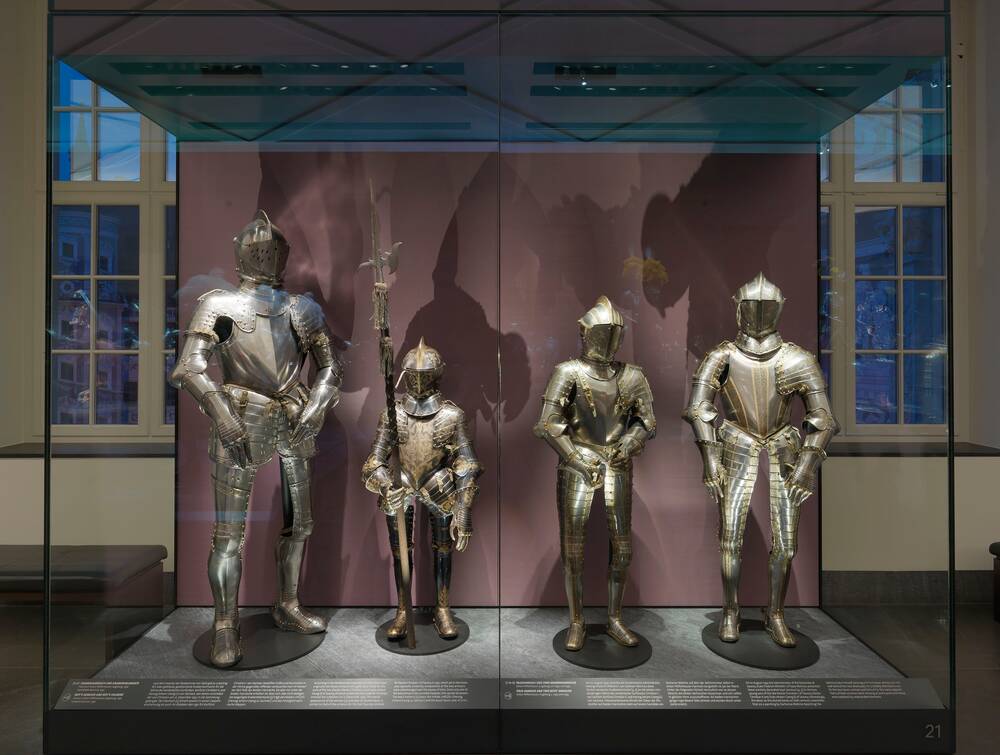A prince’s training began at an early age. In the Dresden Rüstkammer there are several boys’ armours especially made for the young Dukes of Saxony. When they were still quite young they were trained, as their fathers had been, to be a credit to their social status and to represent the principality. It is perhaps interesting to mention here that the suits made of hammered plate metal that were worn by knights for protection in a tournament or in combat were traditionally called harnesses. Nowadays, they are more commonly referred to as “armours” or “suits of armour”. These harnesses or armours were in fact a type of weapon: one used in defence. The term “armour” can also include offensive weapons such as these helmbarts, a kind of halberd with a long spike that demanded a specific combat technique.
This boys’ suit of armour, or harness, still looks brand new, with its blued surface and gold ornamentation of flowers and foliage. It is a miniature foot-tourney harness fashioned for a boy of eight or thereabouts and was made either for Duke Johann Georg I or his elder brother, Christian II. It consists of a visored helmet with a high comb and two gorgets, comprising several interlocking gorget rings; there is a peascod breastplate, strong arm-pieces to cover the shoulders and a fauld to protect the hips. The leg protection is articulated in four sections. Gauntlets protect the young duke’s hands; cuisses shield his thighs and poleyns with side-wings protect his knees; on his legs and feet he has greaves and sabatons.
This harness was made in Augsburg, as we can tell by the pine cone symbol stamped on it in a number of places. That was the seal of the “Augsburg Inspection”, guaranteeing the quality of the metalwork carried out in the city. It appears on both the breastplate and the back of the harness, as well as on the gauntlets and shoulder-pieces. The similarity between this harness and another made for Christian I by the Augsburg armourer Anton Peffenhauser suggests that Peffenhauser also made this boy’s armour. When Christian I died, the other two boys’ brightly polished harnesses also came to Dresden – probably on the orders of Duke Friedrich Wilhelm of Saxony-Weimar, who was serving as regent for the young Christian II at that time. Those two armours were also made in Anton Peffenhauser’s Augsburg workshop.
If you would like to find out more, please listen to the audio under further media.
Further Media
Very little is known about most of the craftsmen of bygone eras. In the case of the majority of sixteenth century armourers, for instance, we rarely know more than their names and where they worked. But this is not the case for Anton Peffenhauser, who made several of the armours that have been preserved in the Dresden collection. He was born in Bavaria in or around 1525. To put it simply: in the right place, at the right time. He was a master armourer who was fortunate enough to establish personal contact with a number of high-ranking clients – kings, electors and other rulers. He also lived in a city that was famous throughout the German-speaking territories for its highly skilled armoursmiths.
“. . . you have to negotiate with him first, when he makes a suit of armour for you. His curious mind will not have it otherwise.”
Thus wrote Balthasar von Trautson, Baron Spechstein, who was one of Peffenhauser’s clients, in a letter to Hans Fugger. Von Trautson clearly respected the man he describes elsewhere as “a strange bird”. Evidently, the famous armour-maker could afford to be difficult – and not just with his clients.
Peffenhauser made a name for himself and did excellent work, with the result that he soon had more orders than he could cope with. This was a common problem for successful master craftsmen, but Peffenhauser, unlike other masters, refused to be beaten by it. Ignoring the regulations of his own guild, he purchased armours made by other craftsmen, embellished them in his workshop, and then sold them on as his own work. The city of Augsburg turned a blind eye to this malpractice – after all, it benefited handsomely from the taxes paid by Anton Peffenhauser.
His first contacts with the Court of Saxony came during the reign of Elector August, who ordered an Italian brigantine from him in 1576. It wasn’t a happy start. August sent the item back because it showed signs of already having been used and didn’t even fit him. In 1582, August placed another order with Peffenhauser; this time, for a tourney armour. He was pleased with the result and this led to the Electors of Saxony placing many more commissions with that “strange bird”, Anton Peffenhauser.
